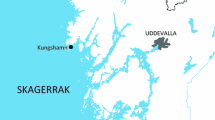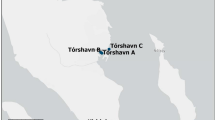Abstract
The objective of this study was to test the hypotheses that (1) free-living marine nematodes respond in a differential way to diesel fuel if it is combined with three trace metals (chromium, copper, and nickel) used as smoke suppressants and that (2) the magnitude of toxicity of diesel fuel differs according to the level of trace metal mixture added. Nematodes from Sidi Salem beach (Tunisia) were subjected separately for 30 days to three doses of diesel fuel and three others of a trace metals mixture. Simultaneously, low-dose diesel was combined with three amounts of a trace metal mixture. Results from univariate and multivariate methods of data evaluation generally support our initial hypothesis that nematode assemblages exhibit various characteristic changes when exposed to different types of disturbances; the low dose of diesel fuel, discernibly non-toxic alone, became toxic when trace metals were added. For all types of treatments, biological disturbance caused severe specific changes in assemblage structure. For diesel fuel-treated microcosms, Marylynnia bellula and Chromaspirinia pontica were the best positive indicative species; their remarkable presence in given ecosystem may predict unsafe seafood. The powerful toxicity of the combination between diesel fuel and trace metals was expressed with only negative bioindicators, namely Trichotheristus mirabilis, Pomponema multipapillatum, Ditlevsenella murmanica, Desmodora longiseta, and Bathylaimus capacosus. Assemblages with high abundances of these species should be an index of healthy seafood. When nematodes were exposed to only trace metals, their response looks special with a distinction of a different list of indicative species; the high presence of seven species (T. mirabilis, P. multipapillatum, Leptonemella aphanothecae, D. murmanica, Viscosia cobbi, Gammanema conicauda, and Viscosia glabra) could indicate a good quality of seafood and that of another species (Oncholaimellus mediterraneus) appeared an index of the opposite situation.


Similar content being viewed by others
References
Ajiwe VIE, Ajibola VO, Martins CMAO (2003) Biodiesel fuels from palm oil, palm oil methylester and ester-diesel blends. Bull Chem Soc Ethiop 17(1):19–26
Austen MC, McEvoy AJ (1997) The use of offshore meiobenthic communities in laboratory microcosm experiments: response to heavy metal contamination. J Exp Mar Biol Ecol 211:247–261
Austen MC, McEvoy AJ, Warwick RM (1994) The specificity of meiobenthic community responses to different pollutants: results from microcosm experiments. Mar Pollut Bull 28:557–563
Ben Garali A, Ouakad M, Gueddari M (2008) Dynamique sédimentaire au niveau de la frange littorale est de Bizerte (nord-est de la Tunisie). Afr Geosci Rev 15(4):337–351
Beyrem H, Aïssa P (2000) Les nématodes libres, organismes-sentinelles de l’évolution des concentrations d’hydrocarbures dans la baie de Bizerte (Tunisie). Cah Biol Mar 41:329–342
Beyrem H, Mahmoudi E, Essid N, Hedfi A, Boufahja F, Aïssa P (2007) Individual and combined effects of cadmium and diesel on a nematode community in a laboratory microcosm experiment. Ecotoxicol Environ Saf 68:412–418
Bhadury P, Austen MC, Bilton DT, Lambshead PJD, Rogers AD, Smerdon GR (2006) Molecular detection of marine nematodes from environmental samples: overcoming eukaryotic interference. Aquat Microb Ecol 44:97–103
Bhadury P, Austen MC, Bilton DT, Lambshead PJD, Rogers AD, Smerdon GR (2008) Evaluation of combined morphological and molecular techniques for marine nematode (Terschellingia spp.) identification. Mar Biol 154:509–518
Boufahja F, Beyrem H, Essid N, Amorri J, Mahmoudi E, Aïssa P (2007) Morphometry, energetics and diversity of free-living nematodes from coasts of Bizerte lagoon (Tunisia): an ecological meaning. Cah Biol Mar 48:121–137
Boufahja F, Hedfi A, Amorri J, Aïssa P, Beyrem H, Mahmoudi E (2011) An assessment of the impact of chromium-amended sediment on a marine nematode assemblage using microcosm bioassays. Biol Trace Elem Res 142:242–255
Boufahja F, Hedfi A, Essid N, Aïssa P, Mahmoudi E, Beyrem H (2012) An observational study on changes in biometry and generation time of Odontophora villoti (Nematoda, Axonolaimidae) related to petroleum pollution in Bizerte bay, Tunisia. Environ Sci Pollut Res 19:646–655
Carman KR, Fleeger JW, Means JC, Pomarico SM, McMillin DJ (1995) Experimental investigation of the effects of polynuclear aromatic hydrocarbons on an estuarine sediment food web. Mar Environ Res 40:289–318
Carman KR, Fleeger JW, Pomarico SM (1997) Response of a benthic food web to hydrocarbon contamination. Limnol Oceanogr 42:561–571
Clarke KR, Gorley RN (2006) Primer V6: user manual/tutorial. Primer-E Ltd, Plymouth
Clarke KR, Warwick RM (2001) Changes in marine communities: an approach to statistical analysis and interpretation, 2nd edn. PRIMER-E, Plymouth, United Kingdom
Cruz Rosa L, Bemvenuti CE (2005) Effects of the burrowing crab Chasmagnathus granulate (Dana) on meiofauna of estuarine intertidal habitats of Patos Lagoon, Southern Brazil. Braz Arch Biol Technol 48(2):267–274
Danovaro R, Fabiano M, Vincx M (1995) Meiofauna response to the Agip Abruzzo oil spill in subtidal sediments of the Ligurian Sea. Mar Pollut Bull 39(2):133–145
Decho AW (1990) Microbial exopolymer secretions in ocean environments: their role (s) in food webs and marine processes. Oceanogr Mar Biol Annu Rev 28:73–153
Decho AW, Lopez GR (1993) Exopolymer microenvironments of microbial flora: multiple and interactive effects on trophic relationships. Limnol Oceanogr 38:1633–1645
Fichet D, Boucher G, Radena G, Miramand P (1999) Concentration and mobilisation of Cd, Cu, Pb and Zn by meiofauna populations living in harbour sediment: their role in the heavy metal flux from sediment to food web. Sci Total Environ 243(244):263–272
Fijalkowska S, Lisowska K, Dlugonski J (1998) Bacterial elimination of polycyclic hydrocarbons and heavy metals. J Basic Microbiol 38:361–369
Flach E, Muthumbi A, Heip C (2002) Meiofauna and macrofauna community structure in relation to sediment composition at the Iberian margin compared to the Goban Spur (NE Atlantic). Prog Oceanogr 52:433–457
Gerlach SA (1978) Food-chain relatioships in subtidal silty sand marine sediments and the role of meiofauna in stimulating bacterial productivity. Oecologia (Berlin) 33:55–69
Gyedu-Ababio TK, Baird D (2006) Response of meiofauna and nematode communities to increased levels of contaminants in a laboratory microcosm experiment. Ecotoxicol Environ Saf 63:443–450
Hamels I, Moens T, Muylaert K, Vyverman W (2001) Trophic interactions between ciliates and nematodes from an intertidal flat. Aquat Microb Ecol 26:61–72
Hedfi A, Mahmoudi E, Boufahja F, Beyrem H, Aïssa P (2007) Effects of increasing levels of nickel contamination on structure of offshore nematode communities in experimental microcosms. Bull Environ Contam Toxicol 79:345–349
Hedfi A, Mahmoudi E, Beyrem H, Boufahja F, Essid N, Aïssa P (2008) Réponse d’une communauté de nématodes libres marins à une contamination par le cuivre: étude microcosmique. Bull Soc Zool Fr 133(1–3):93–102
Heip C, Vincx M, Vranken G (1985) The ecology of marine nematodes. Oceanogr Mar Biol 23:399–489
Hermi M, Mahmoudi E, Beyrem H, Aïssa P, Essid N (2009) Responses of a free-living marine nematode community to mercury contamination: results from microcosm experiments. Arch Environ Contam Toxicol 56:426–433
Juario JV (1975) Nematode species composition and seasonal fluctuation of a sublittoral meiofauna community in the German Bight. Veröff Inst Meeresforsch Bremerh 15:283–337
Klerks PL (1999) Acclimation to contaminants by the grass shrimp Palaemonetes pugio: individual contaminants vs. mixtures. Ecotoxicology 8:277–286
Klerks PL, Moreau CJ (2001) Heritability of resistance to individual contaminants and to contaminant mixtures in the sheepshead minnow (Cyprinodon variegatus). Environ Toxicol Chem 20:1746–1751
Lemaire-Gony S, Lemaire P, Pulsford AL (1995) Effects of cadmium and benzo(a)pyrene on the immune system, gill ATPase and EROD activity of European sea bass Dicentrarchus labrax. Aquat Toxicol 31:297–313
Mahmoudi E, Essid N, Beyrem H, Hedfi A, Boufahja F, Vitiello P, Aïssa P (2005) Effects of hydrocarbon contamination on a free-living marine nematode community: results from microcosm experiments. Mar Pollut Bull 50:1197–1204
Mahmoudi E, Essid E, Beyrem H, Hedfi A, Boufahja F, Vitiello P, Aïssa P (2007) Individual and combined effects of lead and zinc of a free living marine nematode community: results from microcosm experiments. J Exp Mar Biol Ecol 343:217–226
Millward RN, Carman KR, Fleeger JW, Gambrell RP, Portier RJ (2004) Mixtures of metals and hydrocarbons elicit complex responses by a benthic invertebrate community. J Exp Mar Biol Ecol 310:115–130
Moore JW, Ramamoorthy S (1984) In: De Santo RS (ed) Heavy metals in natural waters. Applied and monitoring assessment. Springer Verlag, New-York, p 268
Moore MN, Widdows J, Cleary JJ, Pipe RK, Salkeld PN, Donkin P, Farrar SV, Evans SV, Thompson PE (1984) Responses of the mussel Mytilus edulis to copper and phenanthrene: interactive effects. Mar Environ Res 14:167–183
Ney RE (1990) Where did that chemical go? A practical guide to chemical fate and transport in the environment. Van Nostrand Reinhold, New York
Nicolaidou A, Nott JA (1998) Metals in sediment, seagrass and gastropods near a nickel smelter in Greece: possible interactions. Mar Pollut Bull 36(5):360–365
NOAA (1999) Screening quick reference tables (SQuiRTs). Coastal protection & restoration division. NOAA, USA
Platt HM, Warwick RM (1983) ‘Free living marine nematodes. Part I. British enoplids’. Synopses of the British fauna no 28. Cambridge University Press, Cambridge
Platt HM, Warwick RM (1988) ‘Free living marine nematodes. Part II. British chromadorids.’ Synopses of the British fauna no 38. E. J Brill, Leiden
Riis V, Babel W, Pucci OH (2002) Influence of heavy metals on the microbial degradation of diesel fuel. Chemosphere 49:559–568
Rising B, Sorurbakhsh P, Wu J (2004) Survey of ultra-trace metals in gas turbine fuels. Am Chem Soc Div Fuel Chem 49(1):404
Schratzberger M, Warwick RM (1999) Differential effects of various types of disturbances on the structure of nematode assemblages: an experimental approach. Mar Ecol Prog Ser 181:227–236
Seinhort JW (1959) A rapid method for the transfert of nematodes from fixative to anhydrous glycerine. Nematologica 4:67–69
Singh R, Ingole B (2011) Life history of a free-living marine nematode Daptonema normandicum reared in laboratory. J Environ Biol 32:147–152
Somerfield PJ, Dee JM, Warwick RM (1994) Soft sediment meiofaunal community structure in relation to a long-term heavy metal gradient in the Fal estuary system. Mar Ecol Prog Ser 105:79–88
Tietjen JH (1980) Microbial-meiofaunal interrelationships: a review. Microbiology 110:335–338
Vitiello P, Dinet A (1979) Définition et échantillonnage du méiobenthos. Rapp Comm Int Mer Médit 25:279–283
Warwick RM, Price R (1979) Ecological and metabolic studies on free-living nematodes from an estuarine sand flat. Estuar Coast Mar Sci 9:257–271
Warwick RM, Platt HM, Somerfield PJ (1998) Free living marine nematodes. Part III. British monhysterida. Synopses of the British fauna no 53. Field Studies Council, Shrewsbury
Wieser W (1960) Benthic studies in Buzzards Bay. II. The meiofauna. Limnol Oceanogr 5:121–137
Yoshida M, Hamadi K, Ghrabi A (2002) Solid waste landfills and soil/sediment contamination around Bizerte lagoon: possible pollution sources. Study on environmental pollution of mediterranean coastal lagoons. JICA Research Promotion Programme (RPP-SEPMCL), Initial report, 55–75
Acknowledgments
The research presented in this paper was performed under the auspices of the Tunisian Ministry of High Education and Scientific Research (MHESR). The authors are thankful to Prof. Guy Boucher (Paris, France) for his encouragement and for helping in taxonomic identification. We are also indebted to the officers and the crew of the Faculty of Sciences of Bizerte (Department of Biological Sciences) for their careful deployment of equipment.
Author information
Authors and Affiliations
Corresponding author
Additional information
Responsible editor: Philippe Garrigues
Rights and permissions
About this article
Cite this article
Hedfi, A., Boufahja, F., Ben Ali, M. et al. Do trace metals (chromium, copper, and nickel) influence toxicity of diesel fuel for free-living marine nematodes?. Environ Sci Pollut Res 20, 3760–3770 (2013). https://doi.org/10.1007/s11356-012-1305-2
Received:
Accepted:
Published:
Issue Date:
DOI: https://doi.org/10.1007/s11356-012-1305-2




